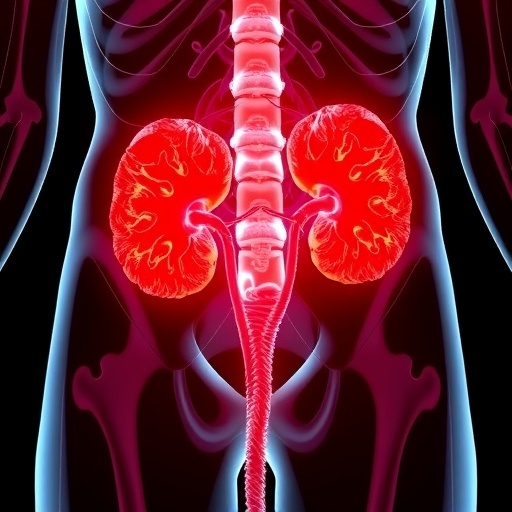In a groundbreaking study published in the prestigious journal BMC Cancer, researchers have unveiled surprising and potentially paradigm-shifting findings regarding the role of urinary paranitrophenol in cancer mortality. Paranitrophenol, a metabolic by-product commonly linked to exposure to organophosphate insecticides, has traditionally been associated with detrimental health consequences. However, new evidence drawn from an extensive analysis of the National Health and Nutrition Examination Surveys (NHANES) suggests a paradoxical relationship: elevated levels of this compound in urine are correlated with a reduced risk of death from cancer.
For decades, organophosphate insecticides and their metabolites like paranitrophenol have been subjects of intense scrutiny due to their prevalent use in agriculture and domestic pest control, alongside their suspected toxicity. Prior epidemiological studies flagged exposure to these chemicals as a public health concern, implicating them in neurological and developmental disorders. Yet, data evaluating their influence on longer-term outcomes such as cancer mortality has been scarce and at times contradictory. The present study represents one of the most comprehensive attempts to unravel this complex association using robust biochemical and statistical methodologies.
.adsslot_xwzSgIn07J{ width:728px !important; height:90px !important; }
@media (max-width:1199px) { .adsslot_xwzSgIn07J{ width:468px !important; height:60px !important; } }
@media (max-width:767px) { .adsslot_xwzSgIn07J{ width:320px !important; height:50px !important; } }
ADVERTISEMENT
A pivotal component of the analysis involved the application of Cox proportional hazards regression models to evaluate the risk of mortality across quartiles of urinary paranitrophenol concentration. The cohort was stratified accordingly, allowing for the investigation of dose-response relationships with both univariate and multivariate adjustments. Adjustments meticulously accounted for demographic variables, lifestyle factors such as smoking and alcohol consumption, and prevalent comorbidities, ensuring that the observed associations were not spurious or confounded.
The results challenged conventional wisdom. While no statistically significant association emerged between urinary paranitrophenol levels and overall mortality, a striking inverse correlation was found with cancer mortality. Participants in the highest quartile of urinary paranitrophenol exhibited a hazard ratio of approximately 0.40 for cancer death relative to those in the lowest quartile, indicating a 60% reduction in risk. This association persisted robustly across unadjusted, partly-adjusted, and fully-adjusted models, underscoring its independence from common confounders.
This counterintuitive finding raises compelling questions about the biological mechanisms underlying the observed phenomenon. One hypothesis posits that paranitrophenol, or related metabolic by-products, might elicit anti-carcinogenic effects at certain exposure levels, potentially through modulation of cellular detoxification pathways or immune responses. Alternatively, the metabolite’s presence could be a biomarker indicative of other protective environmental or lifestyle factors not fully captured in the data. Further mechanistic and translational research is urgently needed to elucidate these pathways and validate these associations.
Critically, the study’s strengths lie in its large-scale, nationally representative sample and the objective biochemical measurement of exposure. The use of NHANES data, which integrates comprehensive health and nutrition assessments with reliable mortality follow-up, lends considerable credibility to the findings. Moreover, the ultra-high-performance LC-MS/MS technique represents a state-of-the-art approach to exposure assessment, far surpassing prior studies reliant on less sensitive measures.
Nevertheless, limitations must be acknowledged. The observational nature of the study precludes definitive causal inference. Residual confounding from unmeasured variables remains possible, as does reverse causation wherein declining health influences metabolite levels. The reliance on a single baseline measurement of urinary paranitrophenol may not fully reflect longitudinal exposure patterns. Finally, generalizability to populations outside the US or with differing exposure profiles warrants careful consideration.
From an epidemiological perspective, these findings underscore the complexity of environmental chemical exposures and their multifaceted relationships with disease endpoints. They highlight the necessity of moving beyond simplistic toxicological assumptions towards a nuanced understanding of dose, timing, and context in risk assessment. Regulatory agencies and public health professionals should take note, but also await corroboration from independent cohorts and experimental models.
The implications for cancer prevention and mortality are profound. Should further studies confirm that higher urinary paranitrophenol levels are protective or indicative of protective processes, this could spur the development of novel biomarkers for cancer prognosis or even inspire new chemopreventive strategies. Conversely, it challenges existing narrative that all organophosphate exposures unequivocally increase cancer risk, prompting reexamination of risk communication and mitigation policies.
This work opens avenues for interdisciplinary collaboration, blending analytical chemistry, molecular biology, environmental epidemiology, and oncology. Robust laboratory investigations are needed to interrogate potential anti-tumorigenic mechanisms of paranitrophenol or its metabolic derivatives. Concurrently, longitudinal population-based studies incorporating repeated exposure measurements can clarify temporal dynamics and causality.
The authors conclude by emphasizing the need for cautious interpretation given the novelty and unexpected direction of their findings. Nonetheless, their research contributes a pivotal piece to the puzzle of environmental determinants of cancer mortality, challenging prevailing dogma and inspiring a reevaluation of organophosphate metabolites in public health discourse.
As research into xenobiotic metabolism and carcinogenesis evolves, this study underscores the power of large-scale biobanked population studies combined with precision analytical methods to uncover hidden protective factors amidst complex exposure matrices. It serves as a potent reminder that environmental chemistry can harbor surprises with profound implications for human health.
In summary, the observed inverse association between urinary paranitrophenol levels and cancer mortality presents an intriguing paradox that defies established toxicological expectations. This evidence invites a deeper inquiry into the physiological and molecular interplay between environmental metabolites and cancer biology, potentially illuminating novel pathways for prevention and intervention in oncology.
Subject of Research: The study investigates the association between urinary levels of paranitrophenol, a metabolite of organophosphate insecticides, and the risk of all-cause and cancer mortality in adults.
Article Title: Urinary paranitrophenol levels and risk of cancer mortality: evidence from NHANES
Article References:
Zhang, W., Liu, G., Yuan, W. et al. Urinary paranitrophenol levels and risk of cancer mortality: evidence from NHANES.
BMC Cancer 25, 1108 (2025). https://doi.org/10.1186/s12885-025-14525-x
Image Credits: Scienmag.com
DOI: https://doi.org/10.1186/s12885-025-14525-x
Tags: agricultural chemicals and public healthbiochemical analysis of paranitrophenolcancer mortality and chemical exposureepidemiological studies on pesticide exposuremetabolic by-products and health outcomesNHANES study on insecticidesorganophosphate insecticides health impactsstatistical methodologies in cancer studiestoxicology of organophosphate metabolitesunexpected health benefits of paranitrophenolurinary biomarkers and cancer researchurinary paranitrophenol and cancer risk





